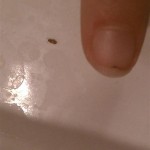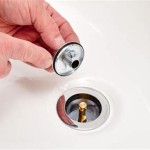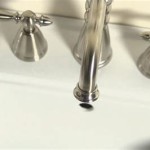How To Clean Hair Out Of Bathroom Sink Drain
A clogged bathroom sink drain, often caused by accumulated hair, is a prevalent household issue. While seemingly insignificant, a slow-draining or completely blocked sink can disrupt daily routines and, if left unattended, potentially lead to more significant plumbing problems. Understanding the causes of hair-related drain clogs and implementing effective cleaning methods is essential for maintaining a functional plumbing system. This article provides a comprehensive guide on diagnosing, preventing, and resolving hair clogs in bathroom sink drains.
The accumulation of hair in bathroom sink drains is primarily due to strands washing down the drain during activities such as shaving, washing hair, or brushing teeth. Hair, unlike water-soluble substances, does not readily dissolve or decompose within the drain system. Its structure allows it to easily tangle and bind to other debris, such as soap scum, toothpaste residue, and mineral deposits. This mixture creates a sticky mass that gradually restricts water flow, eventually leading to a complete blockage. The smaller diameter of drain pipes in bathroom sinks compared to larger plumbing fixtures makes them particularly susceptible to these types of clogs.
Identifying a hair clog early can prevent more severe blockages. The most apparent sign is slow drainage. Water may take significantly longer to empty from the sink basin, or it may drain sluggishly with gurgling sounds. Another indication is an unpleasant odor emanating from the drain. This odor is often caused by the decomposition of organic matter trapped within the clog, combined with stagnant water. In severe cases, the sink may completely fail to drain, resulting in standing water in the basin. If any of these symptoms are observed, it is crucial to address the issue promptly to avoid potential damage to the plumbing system.
Identifying and Gathering Essential Tools
Before attempting to clear a hair clog, it is prudent to gather the necessary tools and materials. This preparation will ensure a more efficient and effective cleaning process. The specific tools required may vary depending on the severity and location of the clog. However, some essential items include: rubber gloves to protect hands from potential exposure to bacteria and harsh chemicals; a pair of pliers or tweezers for removing visible hair and debris; a screwdriver to disassemble drain components; a bucket or container to catch water and debris during disassembly; a drain snake or auger specifically designed for clearing drain clogs; baking soda and white vinegar for a natural cleaning solution; and hot water to flush the drain after cleaning.
In addition to these basic tools, it may be beneficial to have a plunger readily available. While a plunger is typically associated with toilet clogs, it can sometimes be effective in dislodging minor hair clogs in bathroom sinks. A small flashlight can also be helpful for visually inspecting the drain and identifying the location of the clog. Proper lighting will improve visibility and facilitate a more targeted approach to clearing the blockage. Safety glasses are also recommended, particularly when using chemical drain cleaners, to protect the eyes from splashes and potential irritation.
Step-by-Step Cleaning Procedures
Once the necessary tools are gathered, the next step is to implement the cleaning procedure. The specific method employed will depend on the severity and location of the clog. It is always advisable to start with the least invasive methods and progress to more aggressive techniques only if necessary. Begin by visually inspecting the drain opening. Use pliers or tweezers to remove any visible hair or debris from the drain stopper and the surrounding area. This initial step can often clear minor clogs and improve drainage.
If the initial inspection does not resolve the issue, the next step is to try using a plunger. Ensure that there is enough water in the sink to cover the plunger cup. Create a tight seal around the drain opening and vigorously plunge up and down for several minutes. The pressure created by the plunging action may dislodge the clog. After plunging, remove the plunger and observe if the water drains more quickly. Repeat the process if necessary. If plunging proves ineffective, proceed to the next cleaning method.
A natural cleaning solution consisting of baking soda and white vinegar can be effective in dissolving minor hair clogs. Pour approximately one cup of baking soda down the drain, followed by one cup of white vinegar. The mixture will create a fizzing reaction, which helps to break down the accumulated hair and debris. Allow the solution to sit in the drain for at least 30 minutes, or preferably overnight. After the waiting period, flush the drain with hot water for several minutes to remove any remaining residue. If the drain still clogs, consider moving on to more invasive measures.
If the previous steps fail to clear the clog, it may be necessary to disassemble the drain components and manually remove the blockage. Place a bucket or container under the sink to catch any water or debris. Carefully unscrew the drain pipes, starting with the P-trap, which is the curved pipe located beneath the sink. Inspect the inside of each pipe for hair and debris. Use a drain snake or auger to reach further into the drain pipes and remove any stubborn clogs. Thoroughly clean each component before reassembling the drain. Ensure that all connections are tight to prevent leaks.
When using a drain snake or auger, carefully insert the tool into the drain opening. Rotate the handle of the snake to advance it further into the drain pipe. If resistance is encountered, continue rotating the handle to break up the clog. Periodically remove the snake to clean off any accumulated hair and debris. Repeat the process until the snake passes freely through the drain pipe. Once the snake has cleared the clog, flush the drain with hot water to remove any remaining residue. Exercise caution when using a drain snake to avoid damaging the drain pipes.
Preventative Measures for Long-Term Drain Health
Preventing hair clogs from forming in the first place is crucial for maintaining a healthy plumbing system. Implementing preventative measures can significantly reduce the frequency of clogs and minimize the need for extensive cleaning. One of the most effective preventative measures is to install a drain strainer or mesh screen in the sink drain. These devices capture hair and other debris before they enter the drain pipes. Regularly clean the strainer or screen to remove accumulated hair and prevent it from overflowing into the drain.
Avoid pouring grease, oil, or other viscous substances down the drain. These materials can solidify within the drain pipes and contribute to the formation of clogs. Properly dispose of grease and oil in a separate container. Regularly flush the drain with hot water to help dissolve any accumulated soap scum and debris. Hot water can also help to prevent the buildup of mineral deposits within the drain pipes. Consider using enzyme-based drain cleaners periodically to break down organic matter and prevent clogs from forming. However, be cautious when using chemical drain cleaners, as they can be corrosive and potentially damage the drain pipes.
Educating household members about proper drain maintenance is also essential. Encourage them to avoid washing hair in the sink, if possible, and to use drain strainers to catch hair and debris. Remind them not to flush inappropriate items down the drain, such as cotton balls, dental floss, and paper towels. By following these preventative measures, you can significantly reduce the risk of hair clogs and maintain a healthy plumbing system. Regularly inspecting the drain for signs of slow drainage or unpleasant odors can also help to identify and address potential problems early on.
In situations where clogs persist despite the implementation of these cleaning and preventative measures, it may be necessary to consult with a professional plumber. A plumber has specialized tools and expertise to diagnose and resolve more complex plumbing issues. Attempting to address severe clogs without the proper knowledge and equipment can potentially damage the plumbing system and lead to costly repairs. Hiring a plumber can ensure that the clog is cleared effectively and safely, and they can also provide valuable advice on long-term drain maintenance.

Cleaning Hair Out Of A Sink Drain Easy Steps To Remove And Clean Pipes Under Bathroom

How To Quickly Get Hair Out Of A Bathroom Sink

Top 5 Ways To Get Hair Out Of Your Drains

5 Best Ways To Get Hair Out Of Your Drain Stephens Plumbing

How To Clean Hair Out Of A Drain Mike Diamond
How To Get Hair Out Of Drain Like A Pro Frugally

How To Clean Hair Out Of A Drain Nebrasky Plumbing Heating Cooling

How To Clean Hair Out Of A Drain Rooter Hero Plumbing

How To Clean Hair In The Bathroom 14 Expert Approved Ways

How To Remove Hair From Sink Bathtub Drain
Related Posts







